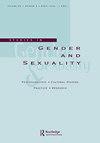Chemsex:在婴儿的快乐和痛苦中重新引入性
Q3 Social Sciences
引用次数: 2
摘要
摘要Chemsex是酷儿在性生活中越来越多的娱乐性吸毒现象,涉及某种心态和特定物质。Chemsex使用者面临着精神分析成瘾治疗文献中已经提到的困难。然而,chemsex也提出了关于酷儿性行为的具体临床挑战。本文主要借鉴了Lacan、Aulagnier、Laplanche、Saketopoulou和Olivienstein的理论,以及我对特定患者的临床工作。它认为,化学性爱可以导致类似于虚假自我的形成的破裂,这种虚假自我被用来将主体性写入一种不稳定的非规范社会纽带,其方式类似于扎尔兹曼的无政府主义驱动。尽管这会带来许多风险,但它也是一种坚持生活的方式,将快乐与酷儿分析者所面临的抑制(如关于虐待或艾滋病毒状况的谈判)脱钩。此外,如果治疗师承认化学性爱是探索性行为的一种手段,甚至像麦克杜格尔关于成瘾的建议那样,是解决陈旧焦虑的一种方法,化学性爱本身也可以成为一种改变的工具。这可能会发生,就像我的病人一样,与治疗和处理具有挑战性的移情反移情同时发生。通过赋予患者的主体性新的意义,并结合过去的创伤经历,有可能获得更充实的生活。本文章由计算机程序翻译,如有差异,请以英文原文为准。
Chemsex: Reintroducing Sexuality in the Pleasure and Pain of the Infans
ABSTRACT Chemsex is the rising phenomenon of recreational drug use during sex among queer people, involving a certain mindset and particular substances. Chemsex users face difficulties already noted in the psychoanalytic addiction treatment literature. However, chemsex also raises specific clinical challenges regarding queer sexuality. This article mainly draws on theories by Lacan, Aulagnier, Laplanche, Saketopoulou, and Olivienstein, and my clinical work with a specific patient. It argues that chemsex can lead to the rupture of formations akin to the false self used to inscribe subjectivity into a precariously heteronormative social bond, in a way that is akin to Zaltzman’s anarchic drive. Despite entailing numerous risks, it is also a means to cling to life, unbinding pleasure from inhibitions faced by queer analysands, such as negotiation of abuse or HIV status. Moreover, chemsex itself can be a vehicle of change, should the therapist admit it as a means of exploring sexuality or even, as McDougall suggests regarding addictions, as a solution to archaic anxieties. This can happen, as with my patient, in tandem with therapy and the processing of the challenging transference-countertransference it entails. In giving new meaning to this patient’s subjectivity and incorporating past traumatic experience, a more fulfilling life has the potential to be attained.
求助全文
通过发布文献求助,成功后即可免费获取论文全文。
去求助
来源期刊

Studies in Gender and Sexuality
Social Sciences-Gender Studies
CiteScore
0.80
自引率
0.00%
发文量
15
期刊介绍:
Beginning in the final two decades of the 20th century, the study of gender and sexuality has been revived from a variety of directions: the traditions of feminist scholarship, postclassical and postmodern psychoanalytic theory, developmental research, and cultural studies have all contributed to renewed fascination with those powerfully formative aspects of subjectivity that fall within the rubric of "gender" and "sexuality." Clinicians, for their part, have returned to gender and sexuality with heightened sensitivity to the role of these constructs in the treatment situation, including the richly variegated ways in which assumptions about gender and sexuality enter into our understandings of "normality" and "pathology."
 求助内容:
求助内容: 应助结果提醒方式:
应助结果提醒方式:


